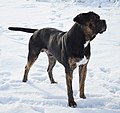Spanish dogo: Difference between revisions
CAPTAIN RAJU (talk | contribs) |
→Temperament: Edited for complete sentences |
||
| Line 36: | Line 36: | ||
== Temperament == |
== Temperament == |
||
Spanish Dogos are known to be sweet and kind to the family. They are tireless and multipurpose workers who are especially endowed for guarding, defense, handling and control of bovine cattle due to their attentive natures. A typical Spanish Dogo should be easy to handle and educate. They tend to be very self-confident.<ref name=":0" /> |
|||
== Gallery == |
== Gallery == |
||
<center class="" style=""> |
<center class="" style=""> |
||
Revision as of 20:21, 8 November 2018
This article has multiple issues. Please help improve it or discuss these issues on the talk page. (Learn how and when to remove these template messages)
|
| Dogo Español | |||||||||||||||||||||||||
|---|---|---|---|---|---|---|---|---|---|---|---|---|---|---|---|---|---|---|---|---|---|---|---|---|---|
 | |||||||||||||||||||||||||
| Other names | Spanish Dogo Spanish Bulldog | ||||||||||||||||||||||||
| Common nicknames | Alano ganadero Perro de toro español | ||||||||||||||||||||||||
| Origin | Spain | ||||||||||||||||||||||||
| |||||||||||||||||||||||||
| Notes | The Dogo Español is currently recognized in its country of origin by the Asociación Canina Nacional, a Spanish Kennel Club | ||||||||||||||||||||||||
| Dog (domestic dog) | |||||||||||||||||||||||||
The Spanish Dogo (Spanish: Dogo español) is a rare Spanish dog breed in the process of recovery. It is closely related to the Spanish Alaunt dog; however, the Spanish Dog is larger in size. The Spanish Dogo is recognized by the Asociación Canina Nacional and consequently by the Alianz Canine Worldwide.[1][2][3][4][5]
The largest populations of the Spanish Dogo are located in Spain in the region of Andalusia and in Norway. The Spanish C.N.D.E (Club Nacional del Dogo Español) Club was founded in 2014 by forerunners of the breed and focuses on Spanish Dogo recovery.[5] The C.N.D.E is headquartered in the province of Seville, concretely in the locality of Utrera.

Historical review
During the period between the end of the fourth and fifth centuries, the Alano people occupied large areas of southern Europe, including the Iberian peninsula. The Alano peoples were accompanied by their catch dogs who mingled with the powerful dogs brought to the peninsula by Phoenicians and Romans. A mixture that gives rise to what would later be called Dogo, Presa or Chato español among other synonyms. Its name is mainly due to its excellent qualities in the handling and control of bovine cattle of brave and semi-wild type, coming from the Iberian peninsula. Later, the appearance of the bullfighting, would make them play a prominent role in the so-called "dog luck" until the beginning of the 20th century. Also, by its qualities for the defense and the guard, it was used like dog of war, being very appreciated by military of other nations, in particular for the control of insurgidos in the Americas.[5]
General appearance
Molosser type, moderately brevile, very strong, rustic and endowed with a tremendous power. Straight and compact back. It has a remarkable sexual dimorphism, showing males a more developed cranial region and a more marked type. From medium to large, brachycephalic, it presents a robust, compact and powerful structure.[5]
Jaws and teeth should be very powerful. Widely enough to allow for correct tooth insertion. Preferably complete (42 teeth). The teeth are not visible with the mouth closed. Canines blunt, short, wide and well separated. Scissor bite, level bite, inverted scissors as well as a slight prognathism that does not exceed 0.5 cm are allowed.[5]
Temperament
Spanish Dogos are known to be sweet and kind to the family. They are tireless and multipurpose workers who are especially endowed for guarding, defense, handling and control of bovine cattle due to their attentive natures. A typical Spanish Dogo should be easy to handle and educate. They tend to be very self-confident.[5]
Gallery
-
Dogo español, sable fawn female
-
Brindle lack-and-tan
-
Dogo español, black-and-tan
-
Black-and-tan
See also
References
- ^ Perros de Trabajo y Utilidad - Alianz Federation (in Spanish)
- ^ Grupos caninos - Canina Nacional ACCAM (in Spanish)
- ^ Spartan Dogs - Perro de Toro Spanish Bulldog
- ^ Spanish Bulldog - Perro de Toro
{{citation}}: Cite has empty unknown parameter:|1=(help) - ^ a b c d e f "DOGO ESPAÑOL | ElMundodelPerro.net", www.elmundodelperro.net (in Spanish)
{{citation}}: Cite has empty unknown parameter:|acess-date=(help)




